Hong Kong and the art of dissent
Simply sign up to the Life & Arts myFT Digest -- delivered directly to your inbox.
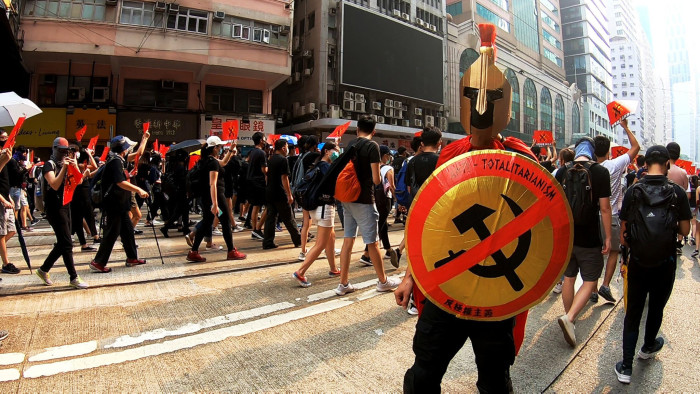
Smoke drifts through the September heat as I make my way towards Hong Kong’s border with the Chinese mainland. It is the evening of the mid-autumn festival, my destination the frontier village of Ping Che. This agricultural region in the city-state’s north-eastern territories has long been the site of creative resistance against the government over the steady clearance of land for real estate.
Tonight, Clara Cheung has invited me to watch a fire dragon dance: a performance she and other artists have created with locals. It is intended as a festive ritual to symbolically protect the village, as well as a thinly veiled act of protest. “When people feel helpless, we need to go back to something older,” says Cheung. “It’s important to connect our present moment to the past.”
The crowd ahead of us turns, then turns again, bearing a giant wicker dragon that has been lanced through with smoking incense sticks. As we walk, the tree line breaks, and the cityscape of Shenzhen on the mainland appears over the horizon, churning the sky with a kaleidoscopic laser display of blue and red light. On our side, the land is cast in darkness, lit only by pools of torchlight and the dragon’s burning bristles.
At the end of the night, the participants pose for photos, waving their fingers in the air to represent “five demands”: the withdrawal of the bill allowing extradition to China that sparked six months of anti-government demonstrations, transforming everyday Hong Kong life into a cauldron of tear gas; the release of protesters from prison; repealing the classification of protests as riots; an independent investigation into police violence; and universal suffrage.
To consider Hong Kong’s age of social explosions, from the 2014 pro-democracy Umbrella movement to today’s bruising protests, is to constantly find oneself asking what it means to live in a disappearing city. The countdown to 2047 continues, when the “one country, two systems” arrangement with China — allowing the region its “high degree of autonomy” — expires. It’s a question that has taken hold of culture across the city-state with urgency, from galleries to graffiti and revolutionary anthems.
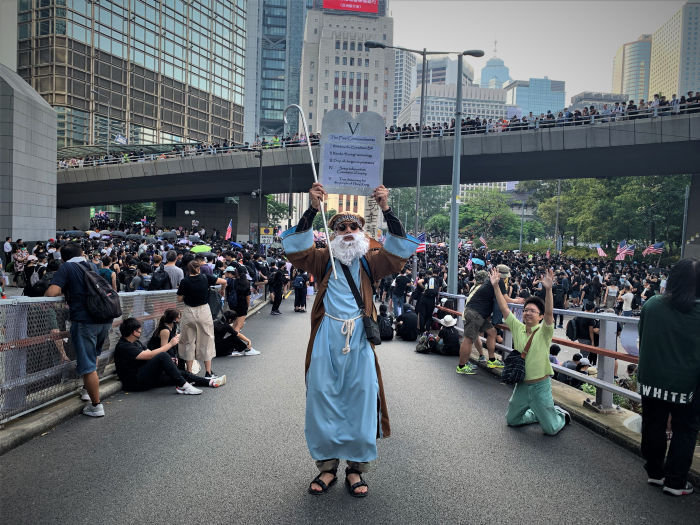
Walking through Hong Kong’s streets this year, I wanted to understand how art had become weaponised, filling the city with an intense visuality that both defines and drives dissent. Consider the art collective Midnight Glue, whose work confronts commuters with images of injustice. They paste up black-and-white images of police brutality on city walls and playfully subvert subway signs. Instead of warning passengers to be mindful of gaps, stickers plastered on trains demand “free all the arrested protesters”.
Kacey Wong thinks he has found another way to fuse creativity with the rhythm of protest. A tall, slender Hong Kong artist in his late forties, with intense eyes and a wide grin, he is well known for the surreal artworks he has paraded through the city’s streets to protest mainland intrusion over the years. These include driving through the city in a pink cardboard tank or pulling along a giant red robot adorned with a yellow hammer and sickle.
At the beginning of this year, Wong wheeled out a mock mobile red-barred prison cell during a protest. “It is like painting the nightmare,” he tells me over a beer. Dressed as a mainland Chinese policeman, he proceeded to “arrest” participants in the pro-democracy demonstration and publicly whip them. But as street violence has escalated, Wong has shifted to nimbler interventions and lighter disguises. “In order to continue my alternative art practice on the front lines, I have to be more agile,” he says.
In a performance in August, which the artist calls “The Five Commandments”, Wong joined the front lines of the protests dressed as Moses, holding a staff and a tablet inscribed with the protesters’ demands. The artist sees the humour and levity he can inject into the crowd as important in a movement charged with heightened emotions and a sense of injustice. “People not only see it, but they enjoy it,” he says. “My existence is to provide a moment of relief, to remind us that art can play a humanistic role even in the worst moments.”
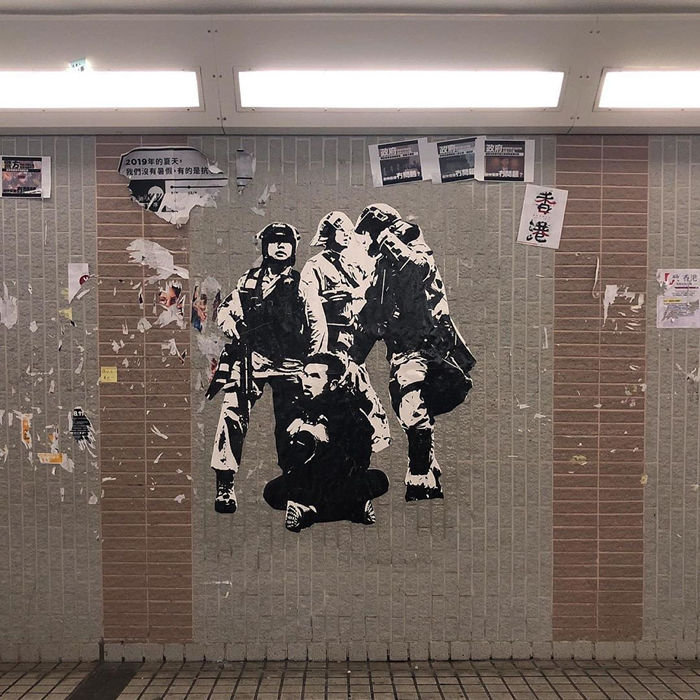
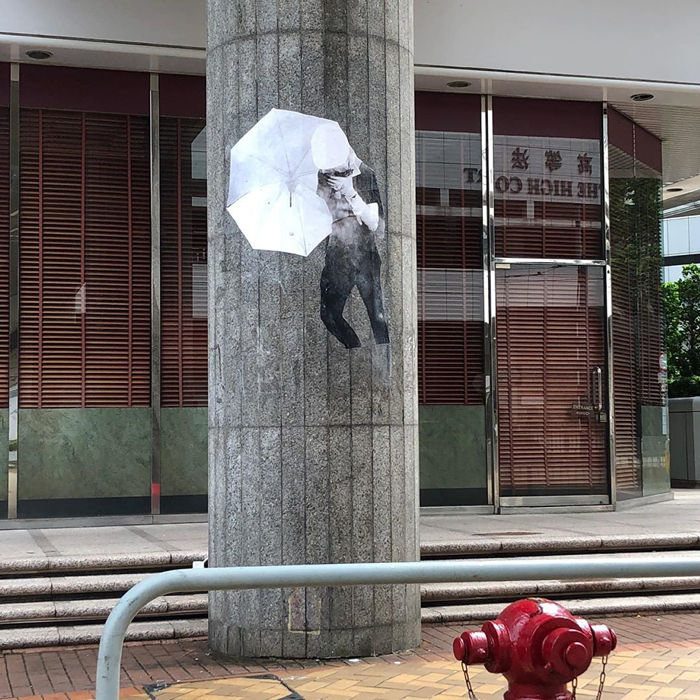
All protests are marked by distinct cultures. You might think of the giant pink octopus shuffled out by Extinction Rebellion protesters in London in October, kettled by police along Whitehall. Or the “human microphone” in New York’s Occupy Wall Street in 2011, in which protesters worked in concentric circles to echo and “amplify” speakers. In France’s gilets jaunes movement, the neon hi-vis jacket has been taken up both as a symbol of “precarious” labour and on a more pragmatic level, as a piece of everyday work wear that allows protesters to easily slip in and out of the crowd. Similarly, in Hong Kong, protesters have had to create a culture that emerges, spreads and vanishes rapidly — a counter to police tactics that seek to take control of the environment itself, filling the air with tear gas.
When I talk to Wong, he is busy making a “Pepe the Frog” lantern to take to Victoria Park for a night-time rally. “He’s so damn ugly,” the artist says. The popularity among Hong Kong’s protesters of the Pepe meme — an anthropomorphic frog derived from a 2006 American comic and famously adopted by the alt-right as a hate symbol — has been controversial. How can an icon of white supremacy become a symbol of the movement in Hong Kong? And yet images of Pepe have proliferated, often glimpsed on T-shirts and banners. Wong tells me that for him, Pepe represents the idea of a frog being slowly cooked alive, a cipher for his home city.
“A meme,” as the researcher Gabriele de Seta, who has been studying the reception of Pepe across China, tells me, “isn’t intrinsically progressive or reactionary or offensive or wholesome.” These images, which have no author and are continuously reworked, are notoriously fluid. “When something becomes a meme it’s always harder to pin down what it ‘means’,’’ he says. “When Hong Kong protesters turned Pepe into an icon, it did not matter to them that other users in the US were overlaying it with racist intentions. If they are using it, it’s because it works.”
Hong Kong’s artists are also searching for quieter ways to express the anguish they feel over their vanishing, threatened home. You see this clearly in the contemporary art gallery Blindspot, whose 15th-floor hexagonal windows overlook the industrial area of Wong Chuk Hang on the southern coast of Hong Kong Island. Towering black-and-white inkjet prints by the local photographer South Ho Siu Nam line the walls. Often capturing the city in the stillness of late night and early morning, the photographs document the wounds inflicted on Hong Kong by last year’s Typhoon Mangkhut: “The Whiteness of Trees” (2018) frames decapitated trees across the city — their mangled limbs strewn across highways, spilling into harbours — against claustrophobic high-rises. These are scenes of the city in ruin.
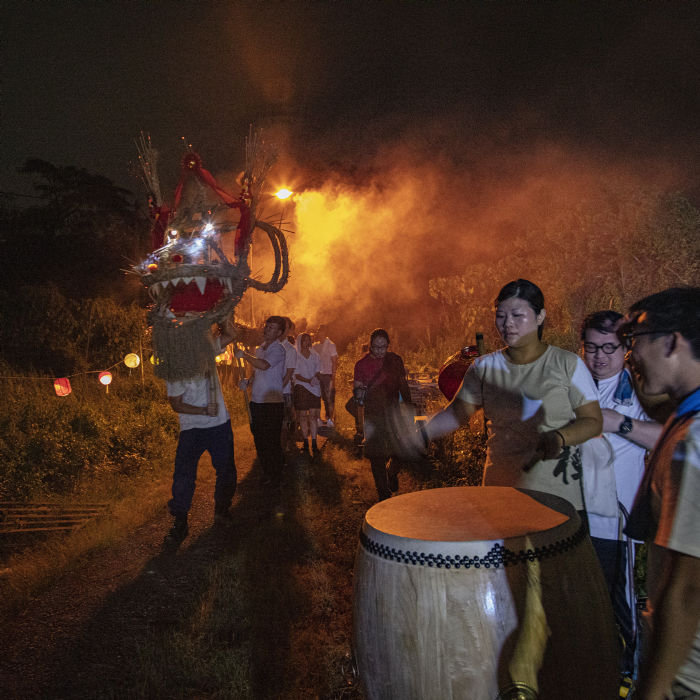
Artists here have been roaming this terrain for decades. As disidentification with “Chineseness” in the city-state continues apace (young people now overwhelmingly regard themselves as Hong Kongers, not Chinese), they have developed ways of coping with a slippery sense of identity. The Hong Kong-born cultural theorist Ackbar Abbas argued in 1997 that the handover — the transfer of sovereignty to mainland China that same year — had led to a profound shift in the city’s cultural production. Suddenly, ideas of Hong Kong as a distinctive home felt under threat. You could see this in the new Hong Kong cinema, Abbas argued, in which directors became obsessed with the foregrounding of time, whether in the moody scenes of faded passion in the works of Wong Kar-wai or the almost impressionistic blurred action of kung-fu films. And as in the 1990s, artists today are fighting to make sense of a city whose identity appears to be slipping away.
I recognise this emotion in another artist at Blindspot, Luke Ching Chin Wai, who has seized on the idea of meteorological crisis as a new way of reflecting on the months of protest that have roiled his home. The bearded 47-year-old is well known in Hong Kong’s art world for his playful, conceptual creations. In a collage of hundreds of postcards showing cityscape scenes of Hong Kong, he marks out raindrop-like strokes that erase the photographs to the point where they become indistinguishable. These fading images soak into my eyes, suggesting something paradoxical: that losing our vision might open new ways of looking at the city.
In his latest artwork, “Panic Disorder” (2019), Ching has strewn the gallery floor with origami cockroaches, meticulously folded out of brown masking tape (the insect is a reference to an insult Hong Kong police have thrown at protesters in recent street clashes). The swarm of cockroaches marching across the gallery breaks the feeling of domestic safety; I tense up.
Other artists in Hong Kong are playing the role of archivists, capturing snapshots of the demonstrations for posterity. One is Yuk King Tan, a warm, generous woman who immediately presses a plate of freshly cut fruit on me when I visit her studio, situated in an industrial area towards the east side of Hong Kong Island. Inside, Tan has been collecting the detritus of protests past — batons, loudspeakers, hard hats — sourced from around the world, including Korea, New Zealand and Hong Kong. “I see myself as documenting these protests,” she tells me, “floating between different worlds.”
Sampson Wong — a young, bespectacled academic, artist and activist — brought a group of designers together at the beginning of this year’s protests in a bid to document all of the city’s “Lennon Walls”. These are named after a wall in Prague on which tributes to John Lennon were posted in 1980, which then transformed into a site to promote pro-democratic opinions under Communist rule. Now hundreds of bright mural collages have sprung up around Hong Kong, carrying messages of hope and support for protesters. Wong’s first move was to preserve a mural in Admiralty, physically saving it in July before the police could tear it down.
Hong Kong’s age of social explosions has been a long time in the making. When I arrived in the city in late November 2014 during the Umbrella movement, the pro-democracy occupation was entering its end game as protesters struggled to find an exit strategy. But in Admiralty, the core of the city, I was transfixed: a sea of tents, it was still filled with pop-up libraries, impromptu concerts and portrait-painting sessions. Monumental pieces of protest art announced war amid the glitter of the luxury and financial districts.
Sometimes you encounter something so powerful, it unsettles you as you walk through it. I remember this sensation from gazing up at a vast rainbow canopy of 250 broken umbrellas (used as shields against clouds of police tear gas), sheltering protesters camped out across a highway: an extraordinary piece of political theatre.
These days, the monumental utopian artworks have gone, and the creativity of the crowd has dispersed across Hong Kong, with artists now much more careful about producing their work rapidly and often anonymously. Thinking about protest art in Hong Kong today as meme-like instigations to action — occupying space, creating actions — helps us understand how a movement with no centralised leadership to direct it has persisted for so long, faced by a war of attrition directed from Beijing.
Through the encrypted messaging app Telegram, it takes little effort to find a student protest at Edinburgh Place, on the waterfront in Hong Kong’s Central district. The mood is relaxed; most have come in the colour of the movement — black — and some wear goggles and helmets, but this afternoon it’s uniform, not armour. As elderly volunteers move through the crowd handing out masks and water, a group of protesters breaks out into stately song. Others drift over to join the cluster of sound. The rest of us stand and listen as the revolutionary anthem “Glory to Hong Kong” unfolds.
Composed by an anonymous musician, the work was originally produced through crowdsourcing volunteers on the Reddit-like online forum LIHKG, who helped by recording themselves singing the piece and contributing suggestions for lyrics.
Several other versions later appeared on the internet, including a film of a full symphony orchestra clad in black protest gear (masks and hard hats) performing in what looks like a vaporous cloud of tear gas. Spectators sang it at a Hong Kong vs Iran football match, and at a shopping mall, one rendition sparked a choral showdown with a pro-Beijing crowd roaring back the Chinese national anthem. To call “Glory to Hong Kong” a song, then, seems insubstantial. This is something more. It is art as meme: transmittable, transmutable, viral.
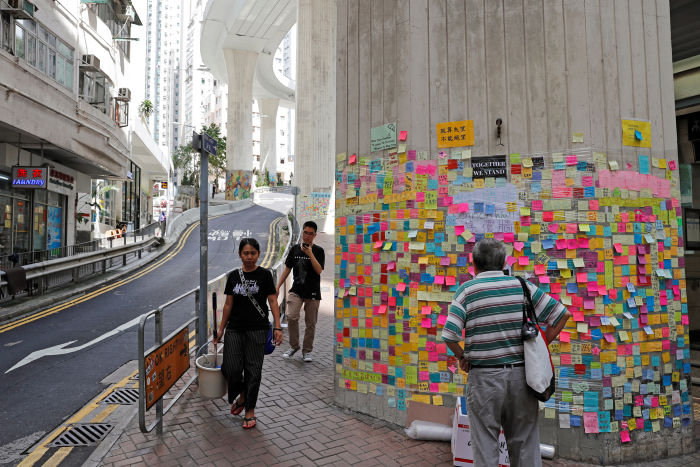
Over the week that follows, as I move from air-conditioned shopping malls to subway stations, I listen to these spaces become impromptu concert halls. This disruption of city space by music gives us important insights into how culture has sustained the movement: it acts as a rallying anthem; it reflects the “flash mob” mentality of the protesters (the constant, melting motion of actions throughout the city, in the face of increasingly militarised police tactics); and it creates moments of viral spectacle that are then re-disseminated across social media. Banners, posters and memes are shared through Telegram groups every minute, and then they flow into real-life, pasted up on to the “Lennon walls” dotted across the city.
The artists of the Hong Kong protests are wielding a sense of aesthetic superiority like a weapon. Distinct from other protest movements across the world, where rough homemade placards are often deployed to lay claim to authenticity, a strong desire to create contagious “beauty” has become a badge of pride in Hong Kong. But it’s more than spectacle. “Creativity is not just on the surface. It drives the movement forward,” Sampson Wong says.
When future historians study this moment, dissecting the reasons why a leaderless movement persisted for so long, surely their attention will be drawn to how culture became the protests’ lifeblood, how it became viral: rapid, infectious and incredibly potent.
En Liang Khong is senior editor of frieze magazine. He is a former BBC Young Composer of the Year. @en_khong
Follow @FTLifeArts on Twitter to find out about our latest stories first. Listen and subscribe to Culture Call, a transatlantic conversation from the FT, at ft.com/culture-call or on Apple Podcasts
Comments